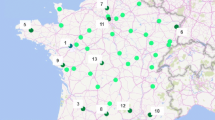Abstract
Conservation, selection and breeding, and propagation constitute the three basic phases of a tree improvement program. To be effective, each of these depends upon accurate pedigree and germplasm documentation. Conceptually, germplasm and their associated pedigrees can be considered genetic resources to be used and managed to improve a domesticated population. These resources typically include various types of open- and control-pollinated families, as well as clones.
Access this chapter
Tax calculation will be finalised at checkout
Purchases are for personal use only
Preview
Unable to display preview. Download preview PDF.
Similar content being viewed by others
References
Adams WT (1983) Application of isozymes in tree breeding. In: Tanksley DD, Orton TJ (ed) Isozymes in plant genetics and breeding, pt A. Elsevier, Amsterdam, pp 381–400.
Adams WT, Neale DB, Loopstra CA (1988) Verifying controlled crosses in conifer tree-improvement programs. Silv Genet 37:147–152.
Beckmann JS (1988) Oligonucleotide polymorphisms: a new tool for genomic genetics. Bio/Technology 6:1061–1064.
Bernatsky R, Tanksley SD (1986) Towards saturated linkage maps in tomato, based on isozymes and random cDNA sequences. Genetics 112:887–898.
Birks JS, Kanowski PJ (1988) Interpretation of the composition of coniferous resin. Silv Genet 37:29–39.
Botstein D, White RE, Skolnick M, Davis RW (1980) Construction of a genetic linkage map in man using restriction fragment length polymorphisms. Am J Human Genet 32:314–331.
Burke T, Bruford MW (1987) DNA fingerprinting in birds. Nature (London) 327:149–152.
Cheliak WM, Pitel JA (1984a) Genetic control of allozyme variants in mature tissues of white spruce trees. J Hered 75:34–40.
Cheliak WM, Pitel JA (1984b) Electrophoretic identification of clones in trembling aspen. Can J For Res 14:740–743.
Cheliak WM, Pitel JA (1984c) Techniques for starch gel electrophoresis of enzymes from forest tree species. Can For Serv Inf Rep PI-X-42.
Cheliak WM, Yeh FC, Pitel JA (1987) Use of electrophoresis in tree improvement programs. For Chron 63:89–96.
El-Kassaby Y, White EE (1985) Isozymes of forest trees: an annotated bibliography. Can For Serv Inf Rep BC-X-267.
Esteban I, Bergmann F, Gregorius H-R, Hutinen O (1976) Composition and genetics of monoterpenes from cortical oleoresin of Norway spruce and their significance for clone identification. Silv Genet 25:59–66.
Fahrlander PD, Klausner A (1988) Amplifying DNA probe signals: a “Christmas tree” approach. Bio/Technology 6:1165–1168.
Friedman ST, Adams WT (1985) Estimation of gene flow into two seed orchards of loblolly pine (Pinus taeda L.). Theor Appl Genet 69:609–615.
Gill P, Jeffreys AJ, Werrett DJ (1985) Forensic application of DNA ‘fingerprints’. Nature (London) 318:577–579.
Hanover JW (1966) Inheritance of 3-carene concentration in Pinus monticola. For Sci 12:447–450.
Harry D (1987) Identification of a locus modifying the electrophoretic mobility of malate dehydrogenase isozymes in incense-cedar (Calocedrus decurreus), and its implications for population studies. Biochem Genet 21:417–434.
Helentjaris T, Slocum M, Wright S, Schaefer A, Nienhuis J (1986) Construction of genetic linkage maps in maize and tomato using restriction fragment length polymorphisms. Theor Appl Genet 72:1229–1231.
Hunter SC (1977) An electrophoretic analysis of isozyme variation in a Piedmont loblolly pine seed orchard. MSc Thesis, NC State Univ, Raleigh.
Jeffreys AJ, Morton DB (1987) DNA fingerprints of dogs and cats. Anim Genet 18:1–15.
Jeffreys AJ, Wilson V, Thein SL (1985a) Hypervariable “minisatellite” regions in human DNA. Nature (London) 314:67–73.
Jeffreys AJ, Brookfield JFY, Semeonoff R (1985b) Positive identification of an immigration test-case using human DNA fingerprints. Nature (London) 317:818–819.
Kossuth SV, Muse D (1986) Cortical monoterpene variation among slash pine ramets by season, aspect, crown position, and bud vigour. For Sci 32:605–613.
Kossuth SV, McCall E, Ledbetter J (1988) Clone certification by use of cortical monoterpenes as biochemical markers. Silv Genet 37:73–76.
Landry BS, Desseli RV, Farrara B, Michelmore RW (1987) A genetic map of lettuce (Lactuca sativa L) with restriction fragment length polymorphism, isozyme, disease resistance and morphological markers. Genetics 116:331–337.
Li H, Gyllensten UB, Xiangfeng C, Saiki RK, Erlich HA, Arnheim N (1988) Amplification and analysis of DNA sequences in single human sperm and diploid cells. Nature (London) 335:414–417.
Libby, WJ (1983) The clonal option. Norw For Res Inst 1432 Ås, NLH.
Mast H (1975) The organization and work of UPOV. Seed Sci Technol 3:377–386.
Miksche JP (ed) (1976) Modern methods in forest genetics. Springer, Berlin Heidelberg New York.
Neale DB, Weber JC, Adams WJ (1984) Inheritance of needle tissue isozymes in Douglas-fir. Can J Genet and Cytol 26:459–468.
Pitel JA, Cheliak WM, Barrett J (1987) Inheritance of allozymes in a black spruce diallel cross. Silv Genet 37:149–153.
Radwan MA, Ellis WD (1975) Clonal variation in monoterpene hydrocarbon of vapours of Douglas-fir foliage. For Sci 21:63–67.
Rottink GR, Hanover JW (1975) Identification of blue spruce cultivars by analysis of cortical oleoresin monoterpenes. Phytochemistry 11:3255–3257.
Strauss SH (1985) The relation of heterozygosity to growth rate and stability among inbred and crossbred knobcone pine (Pinus attenuata Lemm.). PhD Thesis, Univ Cal, Berkeley.
Szmidt AE, El-Kassaby YA, Sigurgeirsson A, Alden T, Lindgren D, Hallgren J-E (1988) Classifying seedlots of Picea sitchensis and P. glauca in zones of introgression using restriction analysis of chloroplast DNA. Theor Appl Genet 76:841–845.
Thorin J, Nommik H (1974) Monoterpene composition of cortical oleoresin from different clones of Pinus sylvestris. Phytochemistry 13:1879–1881.
Author information
Authors and Affiliations
Editor information
Editors and Affiliations
Rights and permissions
Copyright information
© 1993 Springer-Verlag Berlin Heidelberg
About this chapter
Cite this chapter
Cheliak, W.M. (1993). Clone Identification. In: Ahuja, MR., Libby, W.J. (eds) Clonal Forestry I. Springer, Berlin, Heidelberg. https://doi.org/10.1007/978-3-642-84175-0_8
Download citation
DOI: https://doi.org/10.1007/978-3-642-84175-0_8
Publisher Name: Springer, Berlin, Heidelberg
Print ISBN: 978-3-642-84177-4
Online ISBN: 978-3-642-84175-0
eBook Packages: Springer Book Archive




